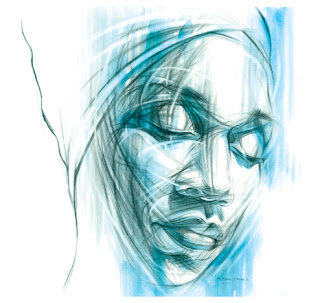"Restless" centres on the dreams of the four main characters after ending an exhausting fight in the last episode. These are used to comment on the characters their fears, their past and their possible future. Consistent in these dreams is the first slayer who hunts and kills them one by one until she in confronted by and dis-empowered by Buffy.
Two Allusions - Faith (" So that my dream that had some stuff about cigars and a tunnel") Faith makes a Freudian kind of joke. Freud believed that things in our dreams where symbolic. Cigars and tunnels would therefore be symbolic with sex.
Buffy - ("Well you have not seen this Adam thing. He is the Terminator without the bashful charm") The little character from the movie The Terminator was far from being bashful or charming. Buffy uses the hyper bile to express just how dangerous Adam is.
Willows dream - Willow is painting Sappho's love poem ` Hymn to Aphrodite` in Greek onto Tara's (her girlfriend) back. She then find herself on Sunnydale High School stage about to perform in a radically changed `Death of a salesman` she is uneasy as she doesn`t know her lines or role. Then Buffy take her to stand in front of a classroom wearing nerdy clothes. Xander mocks her as she nervously begins her book review. Oz (willows ex boyfriend) flirts with Tara while watching Willow doing her book report. Suddenly Willow is attacked and the life is sucked out of her by the first slayer.
Her confusion in the dream represents her lack of self confidence, her fear that she does not fit in or have a place in the world. By her wearing ordinary clothes, which the others comment on the excellence of her `costume` this gives reference to her fear that these friends do not see what she has grown into, but rather what she was when younger, nerdy and awkward. It also suggests that the maze of red curtains on the stage represent the safety and comfort of being with her girlfriend Tara and are a sexual metaphor as well. (Freud her sexuality with another female - Lacan -what she shows to others is an illusion she puts on an act because she is unsure of herself).
Xanders Dream-- Xander wakes up on Buffy's couch, excuses himself to use the restroom finds himself the object of an attempted seduction by Joyce (Buffy's mum) in the restroom he starts to unzip then realises that the bathroom is attached to a large white room with many men in white coats ready to take notes and observe his performance. He then meets Buffy, Giles (Buffy's watcher) and Spike (a vampire) in a playground where Spike tells him Giles is going to teach him to be a watcher, while Buffy plays in a sandbox. Xander then finds himself in an ice cream van with (Anya) (a demon) Willow and Tara they are all dressed in skimpy clothes and heavy make-up they ask him to join them in the back he goes to the back only to find himself in his basement (where he lives) then goes to the University and meets Giles, who starts to reveal the reasons for the dream, but suddenly starts speaking in french. He then finds himself in a reenactment of the `Apocalypse Now`. The scene between a captive Capt. Benjamin Willard and Colonel Walker Kurts. Throughout the sequence Xander end up in his basement again and again. Chased by an unseen pursuer who revealed as the first slayer when she tears his heart out.
The main theme of Xanders dream is his sense of failure and being left behind by his friends he feels stuck throughout his dream by the inability to leave the basement bedroom in his parents house. Also by being the only one not at collage with the others he feels anxiety about his ability to understand (ideas and conversations) and keep up with them. This is further shown when Buffy and Willow tells him "We are well ahead of you)". Underscoring his fear that this is really the case. (Freud - young son whats to replace father as the main focus in the family life and sexually).
Giles Dream - Begins with Giles swinging a watch in front of Buffy (a Watcher is a mentor and trainer). They are in Giles apartment which has no furniture other than a chair and a bed. Buffy laughs ,then the dream cuts to his family with Buffy and his girlfriend Olivia at a fairground, quicker than the others to realise something is wrong he confronts Spike who is posing for a photo shoot in his crypt. In the Bronze (a club) he meets Anya failing as a stand up comedian and Willow and Xander,(with a bloody chest wound) warns him of their attacker. He then breaks in to song, giving suggestions on how to deal with what hunts them, but the sound system breaks down, He then crawls backstage to trace a wiring fault be begins to realise his pursuer is the first slayer just as she (slayer) scalps him.
Giles is represented with two choices whether to remain a father figure to Buffy or begin his own life. This is shown by the appearance of his girlfriend Olivia who pushes an empty baby stroller. In this dream of the dream Buffy is dressed as a child unable to throw a ball without his help, this being an indication of that Buffy will not be able to do her job without him. Then we see Olivia weeping this signifies elements of his unfulfilled life i.e. marriage and children.
Final Dream Sequence
Buffy is woken by Anya in her dorm. room, then finds herself in her room at home. Then Tara speaks cryptically about the future. At the University Buffy talks to her mother who lives in the walls, then meets Riley (was her boyfriend I think) at the Initiative. He is promoted to surgeon general and is drawing plans with Adam for world domination, the three of them are interrupted by a demon attack and Riley and Adam make a pillow fort, When Buffy finds her weapons bag it only contains mud which she smears on her face. She is transported to the dessert and finally meets the First Slayer through Tara the First Slayer tells Buffy that she must work on her own which she (Buffy) rejects.The major theme of Buffy's dream is her fear of the personal cost of her life as a slayer the isolation and the loneliness she is forced to endure.
Further notes - The opening dream sequence focused though Willow, illustrates the way that language dissociates us from our own desires (Lacan's psychoanalysis) By sexualizing the painting on Tara's back could this exemplify a point made by Freud; "The most prominent of the parts of the body from which libido arises are known as 'erotogenic zones' although in fact the whole of the body is an erotogenic zone of its own kind.
Xanders continual return (in the dream sequence) is to the scene of his childhood trauma (the basement of his home) perfectly illustrates Freud's understanding of repetition compulsion. Xander also exhibits the classic desire (oedipal) for the mother though his sexual encounter with "Buffy's mum," this ties up with the phallic phase of development (Xander's visit to the bathroom but cannot perform due to the gaze of his father which changes into doctors.
extracts taken from Prof. Fellugu. (felluga/373 engl 373 the theory of SF-F.
























































